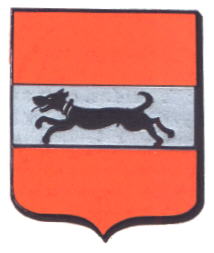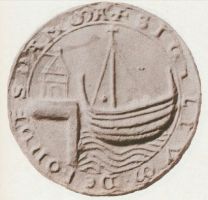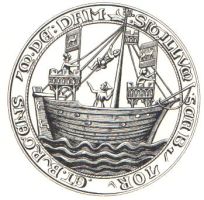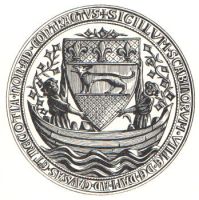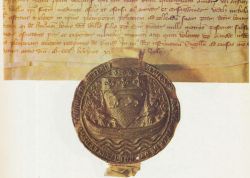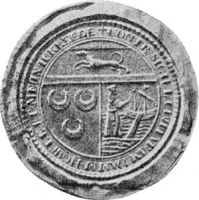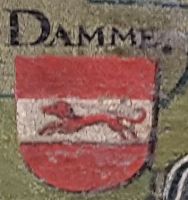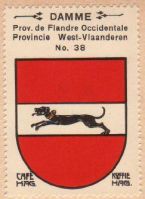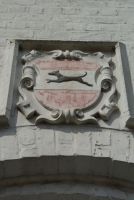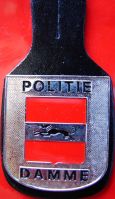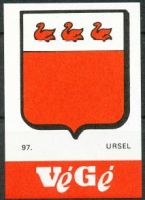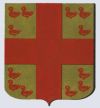Damme: Difference between revisions
Knorrepoes (talk | contribs) m (Text replacement - "Literature :" to "'''Literature''':") |
Knorrepoes (talk | contribs) No edit summary |
||
| Line 1: | Line 1: | ||
{{ | {| class="wikitable" | ||
''' | |- style="vertical-align:top;" | ||
|[[File:damme.jpg|center|alt=Wapen van {{PAGENAME}}/Arms (crest) of {{PAGENAME}}]] | |||
| | |||
'''Country''' : Belgium [[File:Belgium.jpg|60 px|right]]<br><br><br> | |||
'''Province''' : <br>[[West-Vlaanderen]][[File:Westvlaanderen.jpg|60 px|right]]<br><br><br> | |||
'''Additions:''' | |||
* 1976 [[Moerkerke]] | |||
** 1970 [[Hoeke]] | |||
** Lapscheure | |||
* 1976 [[Oostkerke (Damme)|Oostkerke]] | |||
* 1976 [[Sijsele]] | |||
<br> | |||
{{#display_map:51.2514,3.28105|width=250|height=250|zoom=7}} | |||
|} | |||
{| class="wikitable" | |||
|+Official blazon | |||
|- | |||
|'''Dutch''' | |||
| | |||
* (1838) Rood koleur met eene witte dwarsstreep belaeden met eenen loopenden hond van zwart koleur met eenen halsband van zulke kleur. | |||
* (1981) In keel een dwarsbalk van zilver, beladen met een springende gehalsbande hond van sabel. | |||
|- | |||
|'''French''' | |||
| | |||
* (1838) De gueules à la fasce d'argent, chargé d'un chien courant de sable accollé de même. | |||
|- | |||
|'''English''' | |||
| blazon wanted | |||
|} | |||
===Origin/meaning=== | ===Origin/meaning=== | ||
The arms were officially granted on February 2, 1838 and again on March 13, 1981. | The arms were officially granted on February 2, 1838 and again on March 13, 1981. | ||
Damme, or Hondsdamme, received city rights in 1180 by Filips of the Alsace, Count of Vlaanderen. The oldest seal of the city shows a ship, probably a Hanseatic kogge. The contra-seal already shows a dog on a bridge with water in the base. The second seal, from around 1300, shows a ship with a flag or banner with the dog. Later | Damme, or Hondsdamme, received city rights in 1180 by Filips of the Alsace, Count of Vlaanderen. The oldest seal of the city shows a ship, probably a Hanseatic kogge. The contra-seal already shows a dog on a bridge with water in the base. The second seal, from around 1300, shows a ship with a flag or banner with the dog. Later seals show either a ship with a banner, or the arms with a dog on a bar. On one seal the chief of the arms shows three fleur-de-lys, probably for the Count of Vlaanderen at the time. | ||
In 1594 the former small cities of [[Hoeke]] and [[Oostkerke (Damme)|Monnikerede]] were merged with Damme. In the new city council each of the old cities were represented by one person. At the same time a new seal was made, combining the arms of the three cities, see below. | |||
In 1813 Damme and Hoeke became independent municipalities, Monnikerede by the time had disappeared and the area became part of the municipality of Oostkerke. Both Hoeke and Oostkerke became again part of Damme in 1976. | |||
The dog on the silver bar is probably a canting element for the old name, Hondsdamme, hond being Dutch for dog. The name, however, means a dam in/near the Honte river and has nothing to do with dogs.<br> | The dog on the silver bar is probably a canting element for the old name, Hondsdamme, hond being Dutch for dog. The name, however, means a dam in/near the Honte river and has nothing to do with dogs.<br> | ||
Ever since the 14th century the arms have remained the same; the colours are known since the late 15th century. | Ever since the 14th century the arms have remained the same; the colours are known since the late 15th century. | ||
<gallery widths=250px heights=200px perrow=0> | |||
| | File:dammez1.jpg|alt=Zegel van Damme/Seal of Damme|Seal of Damme from the first half of the 13th century | ||
File:dammez2.jpg|alt=Zegel van Damme/Seal of Damme|Seal of Damme from around 1300 | |||
File:dammez3.jpg|alt=Zegel van Damme/Seal of Damme|Seal of Damme from the second half of the 14th century | |||
File:dammez4.jpg|alt=Zegel van Damme/Seal of Damme|Seal of Damme on a charter of July 19, 1371 (Lübeck city archive) | |||
| | File:dammez5.jpg|alt=Zegel van Damme/Seal of Damme|Seal of Damme, Hoeke and Monnikerede from 1594<br>(Gruuthusemuseum, Brugge) | ||
File:damme.map.jpg|alt=Wapen van Damme/Arms (crest) of Damme|The arms on the map of Pieter Pourbus (1571, Groeningemuseum, Brugge) | |||
File:damme.hagbe.jpg|alt=Wapen van Damme/Arms (crest) of Damme|The arms in the [[Koffie Hag Belgium|Koffie Hag/Café Hag albums]] +/- 1930 | |||
File:damme2.jpg|alt=Wapen van Damme/Arms (crest) of Damme|The arms as seen in the city | |||
File:damme.pol.jpg|alt=Wapen van Damme/Arms (crest) of Damme|The arms on a police badge ([http://blog.seniorennet.be/police_politie_insignes/ source]) | |||
File:097.vgb.jpg|alt=Wapen van Damme/Arms (crest) of Damme|The arms on a [[VéGé (matchbox labels)|VéGé]] match label | |||
</gallery> | |||
[[Civic Heraldry Literature - Belgium|'''Literature''']]: Servais, 1955; Ewe, 1972 | |||
{ | {{be1}} | ||
{{media1}} | |||
{{ | |||
[[Category:Belgian Municipal Arms D]] | [[Category:Belgian Municipal Arms D]] | ||
Revision as of 08:41, 21 January 2023
|
Country : Belgium Province : West-Vlaanderen Additions:
|
| Dutch |
|
| French |
|
| English | blazon wanted |
Origin/meaning
The arms were officially granted on February 2, 1838 and again on March 13, 1981.
Damme, or Hondsdamme, received city rights in 1180 by Filips of the Alsace, Count of Vlaanderen. The oldest seal of the city shows a ship, probably a Hanseatic kogge. The contra-seal already shows a dog on a bridge with water in the base. The second seal, from around 1300, shows a ship with a flag or banner with the dog. Later seals show either a ship with a banner, or the arms with a dog on a bar. On one seal the chief of the arms shows three fleur-de-lys, probably for the Count of Vlaanderen at the time.
In 1594 the former small cities of Hoeke and Monnikerede were merged with Damme. In the new city council each of the old cities were represented by one person. At the same time a new seal was made, combining the arms of the three cities, see below.
In 1813 Damme and Hoeke became independent municipalities, Monnikerede by the time had disappeared and the area became part of the municipality of Oostkerke. Both Hoeke and Oostkerke became again part of Damme in 1976.
The dog on the silver bar is probably a canting element for the old name, Hondsdamme, hond being Dutch for dog. The name, however, means a dam in/near the Honte river and has nothing to do with dogs.
Ever since the 14th century the arms have remained the same; the colours are known since the late 15th century.
The arms in the Koffie Hag/Café Hag albums +/- 1930
The arms on a police badge (source)
The arms on a VéGé match label
Literature: Servais, 1955; Ewe, 1972
This page is part of the Belgium heraldry portal/ Belgische overheidswapens/ Armorial de Belgique
|
|
